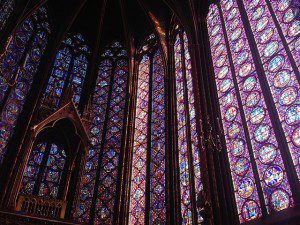
When I was a very small girl, my family went to Mass at the Cathedral. I loved everything about it. I loved coming inside from the bright sunshine to the dark foyer, all built of sandy stone that looked like it was covered in sugar. There was hardly any light in the foyer; it was blocked off on one end by the grille that surrounded the Baptismal font, like the bars to a cage in a dungeon. There were holy water fonts recessed into the scratchy tan stone, and the inside doors were dark and strange. It was like walking into a witch’s cave. Then we went into the main church, and it was as though we were outside again– in a different kind of outside, a sacred outside. The ceiling was so high, it felt like a different and alien sky. The sunlight was alien light, broken from white light into a thousand colors through the stained glass. Rumblings from the great pipe organ sent vibrations through the floor tiles and up into my chest, a strange, beautiful, massive sound that shook my whole being. I was in Church, and Church was different from anywhere else. Church was not preschool, or home, or the grocery store. Church was the portal of Heaven, the different place, the place that was opener and quieter, yet louder and more massive than anything I knew. As a little girl, I shuddered with the feeling I grew up to call “numinous dread.” I knew what it meant to be in Church.
Years later, when I was a teenager, my family visited south Florida. We went to a church that was of a modern design. Some say modern churches are always appalling, but I don’t agree; this one was fine. The nave was big and airy, and the colors were light. The windows were of seaglass in abstract patterns. It was like going to Mass on the beach, outside in God’s creation, and that wasn’t inappropriate. Around the walls were a Way of the Cross done in abstract, a series of cast metal symbols. We sat near the eleventh and twelfth stations. Christ being nailed to the cross, as I recall, was symbolized by a single hand, a nail in the middle, the fingers curled in agony. Pain, expressed simply. Christ’s death was depicted as a human figure with the arms outstretched, draped in a very loose shroud. It was, somehow, the most frightening, awe-inspiring depiction of death that I’d ever seen. What did it mean to die– what did it mean when God died, when He who is Life itself went behind the shroud that covers all mankind? Again, I felt numinous dread. I knew what it meant to be in Church.
A reader asked an excellent question after yesterday’s vehement post decrying bad religious art. “The problem that I have with this opinion piece is that the author never defines what IS considered aesthetically pleasing. I think this is a philosophical issue. While I agree that bad art does do damage, how can one distinguish between which art is “bad,” and which art is “good” ?”
What a brilliant question. Now, I’m a lover of philosophy and aesthetics. I love talking abstractly and in the most snooty, highbrow terms about art. I love throwing around phrases like “catharsis” and “grotesque;” I love to talk about the sublime and the uncanny. I like everything to do with Aesthetics and the study of art. I could give you a ten thousand word answer with a huge bibliography if you waited long enough. Indeed, that’s what I should be doing. My MA thesis is on art, and it’s past due. But for the moment, in the space of a blog post, I can give you a very coherent and not-too-philosophical answer to that question. Good art– be it architecture, painting, sculpture, literature, music or films– good art does what it’s supposed to do. Bad art, on the other hand, doesn’t do what it’s supposed to do.
It doesn’t take a lot of aesthetic training to be able to tell the difference. When you walk into a Catholic church, how should you feel and what should you be thinking? Shouldn’t you feel and think about God? If your modern church design is so nifty and transgressive that all people can do is quietly wonder if they’re actually in a space ship, you’ve built a bad Catholic church. And this is not only a problem for modern churches. If your “traditional” church is so preoccupied with being “traditional,” so crawling with baroque scrollwork and tormented statues and hysterionic overly embroidered chausibles that all the congregation can feel is a sense that they have, indeed, stumbled across a “traditional” church, then it’s a bad church as well– the focus is not on God, but on somebody’s idea of tradition. We can’t induce devotion or numinous dread, but if a building is built to be prayed in, that’s the ambiance we should strive to create.
We all can think of good examples of visual art, inside and outside the Christian tradition. Pieces of art that we like to have around, because they are beautiful and because they inspire us to think. Most people can think of abstract modern art pieces that fit this criterion as well, though I think they’re rarer and more difficult for the artist to get right. And we can all name bad art– the bizarre abstract images on the fronts of disposable hymnals, the poorly painted and kitschy religious statuettes you might find at a garage sale and buy out of pity for the saint so badly depicted. Most Catholics I know have a closet full of such bad art they’re afraid to throw away.
The same rule of thumb is true for music. If Christian music inspires a self-satisfied sense that we’re more reasonable than those silly atheists, it’s bad music. It’s equally bad if all it inspires is giggles at the inane lyrics. And music can be good for one occasion and bad for another: the way we open a Charismatic prayer service might not be a good choice for the opening of Mass. Books follow suit: a bad Christian novel will create a shallow warm fuzzy feeling, or mere anger at having wasted one’s time. Good books inspire empathy, deep thought and increased understanding, and a book about Christ ought to do this even more. Films are in many ways like books; they’re meant to lead the audience through the process known as catharsis, facing and healing our deepest emotions; they’re to develop our empathy and help us reflect upon our culture and history. A film that leaves the audience giggling at sad parts and squirming with embarrassment at the humor doesn’t accomplish this, and it’s a bad film. So is a film that never challenges anyone, but goes for easy and predictable thrills. An actor who can’t convey emotion, but just sits there looking glamorous, is a bad actor. A writer who has nothing interesting or challenging to say is a bad writer as surely as a camera with a lens that won’t focus is a bad camera. They’re not doing what they’re supposed to do.
Art serves many purposes, and those purposes can be debated endlessly. But at minimum, devotional art should aid our devotion, and art labeled “Christian” should bring us into a relationship with Christ. Art, however well-meaning, which fails to do this in the majority of its audience members is bad art. Bad art alienates people from its subject. Since the subject of Christian art is Christ, every Christian artist ought to be deeply concerned with making sure their work is truly good art.
(Image courtesy of Pixabay)













